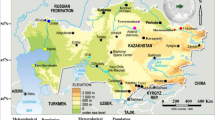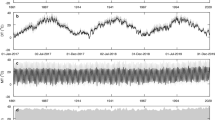Abstract
This paper explores urban temperature in Hong Kong using long-term time series. In particular, the characterization of the urban temperature trend was investigated using the seasonal unit root analysis of monthly mean air temperature data over the period January 1970 to December 2013. The seasonal unit root test makes it possible to determine the stochastic trend of monthly temperatures using an autoregressive model. The test results showed that mean air temperature has increased by 0.169◦C (10 yr)−1 over the past four decades. The model of monthly temperature obtained from the seasonal unit root analysis was able to explain 95.9% of the variance in the measured monthly data — much higher than the variance explained by the ordinary least-squares model using annual mean air temperature data and other studies alike. The model accurately predicted monthly mean air temperatures between January 2014 and December 2015 with a root-mean-square percentage error of 4.2%. The correlation between the predicted and the measured monthly mean air temperatures was 0.989. By analyzing the monthly air temperatures recorded at an urban site and a rural site, it was found that the urban heat island effect led to the urban site being on average 0.865◦C warmer than the rural site over the past two decades. Besides, the results of correlation analysis showed that the increase in annual mean air temperature was significantly associated with the increase in population, gross domestic product, urban land use, and energy use, with the R2 values ranging from 0.37 to 0.43.
Similar content being viewed by others
References
Beaulieu, J. J., and J. A. Miron, 1993: Seasonal unit roots in aggregate U.S. data. Journal of Econometrics, 55(1–2), 305–328.
Camilloni, I., and V. Barros, 1997: On the urban heat island effect dependence on temperature trends. Climatic Change, 37(4), 665–681.
Chan, H. S., M. H. Kok, and T. C. Lee, 2012: Temperature trends in Hong Kong from a seasonal perspective. Climate Research, 55(1), 53–63.
Chattopadhyay, S., and D. R. Edwards, 2016: Long-term trend analysis of precipitation and air temperature for Kentucky, United States. Climate, 4, 10, doi: 10.3390/cli4010010.
Chen, K., L. Huang, L. Zhou, Z. W. Ma, J. Bi, and T. T. Li, 2015: Spatial analysis of the effect of the 2010 heat wave on stroke mortality in Nanjing, China. Scientific Reports, 5, 10816, doi: 10.1038/srep10816.
Chen, X. L., H. M. Zhao, P. X. Li, and Z. Y. Yin, 2006: Remote sensing image-based analysis of the relationship between urban heat island and land use/cover changes. Remote Sens. Environ., 104, 133–146.
Conti, S., P. Meli, G. Minelli, R. Solimini, V. Toccaceli, M. Vichi, C. Beltrano, and L. Perini, 2005: Epidemiologic study of mortality during the summer 2003 heat wave in Italy. Environ. Res., 98(3), 390–399.
Debbage, N., and J. M. Shepherd, 2015: The urban heat island effect and city contiguity. Computers, Environment and Urban Systems, 54, 181–194.
Dickey, D. A., and W. A. Fuller, 1981: Likelihood ratio statistics for autoregressive time series with a unit root. Econometrica, 49, 1057–1072.
Erdem, H. H., and Coauthors, 2010: Thermodynamic analysis of an existing coal-fired power plant for district heating/cooling application. Applied Thermal Engineering, 30(2–3), 181–187.
Franses, P. H., 1991: Seasonality, non-stationarity and the forecasting of monthly time series. International Journal of Forecasting, 7(2), 199–208.
Franses, P. H., and B. Hobijn, 1997: Critical values for unit root tests in seasonal time series. Journal of Applied Statistics, 24(1), 25–48.
He, Y. T., G. S. Jia, Y. H. Hu, and Z. J. Zhou, 2013: Detecting urban warming signals in climate records. Adv. Atmos. Sci., 30(4), 1143–1153, doi: 10.1007/s00376-012-2135-3.
Hinkel, K. M., F. E. Nelson, A. E. Klene, and J. H. Bell, 2003: The urban heat island in winter at Barrow, Alaska. International Journal of Climatology, 23(15), 1889–1905.
HKEMSD, 2005a: Hong Kong Energy End-Use Data 1993–2003. Hong Kong Electrical and Mechanical Services Department, Hong Kong. p.3.
HKEMSD, 2015b: Hong Kong Energy End-Use Data 2003–2013. Hong Kong Electrical and Mechanical Services Department, Hong Kong. p.60.
Hu, X. M., M. Xue, P. M. Klein, B. G. Illston, and S. Chen, 2016: Analysis of urban effects in Oklahoma City using a dense surface observing network. J. Appl. Meteor. Climatol., 55, 723–741.
Hu, Y. H., and G. S. Jia, 2010: Influence of land use change on urban heat island derived from multi-sensor data. International Journal of Climatology, 30(9), 1382–1395.
Huang, S. P., M. Taniguchi, M. Yamano, and C. H. Wang, 2009: Detecting urbanization effects on surface and subsurface ther-mal environment—A case study of Osaka. Science of the Total Environment, 407, 3142–3152.
IPCC, 2007: Climate Change 2007: The Physical Science Basis. Contribution of Working Group I to the Fourth Assessment Report of the Intergovernmental Panel on Climate Change, Solomon et al., Eds., Cambridge University Press, Cambridge, United Kingdom and New York, NY, USA, 996pp.
Kalnay, E., and M. Cai, 2003: Impact of urbanization and land-use change on climate. Nature, 423(6939), 528–531.
Kataoka, K., F. Matsumoto, T. Ichinose, and M. Taniguchi, 2009: Urban warming trends in several large Asian cities over the last 100 years. Science of the Total Environment, 407(9), 3112–3119.
Kim, Y. H., and J. J. Baik, 2002: Maximum urban heat island intensity in Seoul. J. Appl. Meteor., 41(6), 651–659.
Lenten, L. J. A., and I. A. Moosa, 2003: An empirical investigation into long-term climate change in Australia. Environmental Modelling & Software, 18(1), 59–70.
Leung, Y. K., M. C. Wu, K. K. Yeung, and W. M. Leung, 2007: Temperature projections in Hong Kong based on IPCC fourth assessment report (Hong Kong Observatory, Trans.). [Available online at: http://www.weather.gov.hk/publica/reprint/r764.pdf.]
Li, J. X., C. H. Song, L. Cao, F. G. Zhu, X. L. Meng, and J. G. Wu, 2011: Impacts of landscape structure on surface urban heat islands: A case study of Shanghai, China. Remote Sensing of Environment, 115(12), 3249–3263.
Li, Q., H. Zhang, X. Liu, J. Huang, 2004: Urban heat island effect on annual mean temperature during the last 50 years in China. Theor. Appl. Climatol., 79(3–4), 165–174.
Lo, C. P., and D. A. Quattrochi, 2003: Land-use and land-cover change, urban heat island phenomenon, and health implications: A remote sensing approach. Photogrammetric Engineering & Remote Sensing, 69(9), 1053–1063.
Michelozzi, P., and Coauthors, 2007: Assessment and prevention of acute health effects of weather conditions in Europe, the PHEWE project: Background, objectives, design. Environmental Health, 6, 1–10, doi: 10.1186/1476-069X-6-12.
Nichol, J. E., 1996: Analysis of the urban thermal environment with Landsat data. Environment and Planning B: Planning & Design, 23, 733–747.
Nichol, J. E., 2005: Remote sensing of urban heat islands by day and night. Photogrammetric Engineering & Remote Sensing, 71(5), 613–621.
Nijman, T. E., and F. C. Palm, 1990: Predictive accuracy gain from disaggregate sampling in ARIMA models. Journal of Business & Economic Statistics, 8(4), 405–415.
Ning, L., and R. S. Bradley, 2014: Winter precipitation variability and corresponding teleconnections over the northeastern United States. J. Geophys. Res. Atmos., 119, 7931–7945.
Ning, L., E. E. Riddle, and R. S. Bradley, 2015: Projected changes in climate extremes over the northeastern United States. J. Climate, 28, 3289–3310.
Oke, T. R. 1973: City size and the urban heat island. Atmos. Environ., 7(8), 769–779.
Ren, G. Y., Y. H. Ding, Z. C. Zhao, J. Y. Zheng, T. W. Wu, G. L. Tang, and Y. Xu, 2012: Recent progress in studies of climate change in China. Adv. Atmos. Sci., 29(5), 958–977, doi: 10.1007/s00376-012-1200-2.
Siu, L. W., and M. A. Hart, 2013: Quantifying urban heat island intensity in Hong Kong SAR, China. Environmental Monitoring and Assessment, 185(5), 4383–4398.
Sonali, P., and D. N. Kumar, 2013: Review of trend detection methods and their application to detect temperature changes in India. J. Hydrol., 476, 212–227.
To, W. M., 2014: Association between energy use and poor visibility in Hong Kong SAR, China. Energy, 68, 12–20.
To, W. M., 2015: Greenhouse gases emissions from the logistics sector: the case of Hong Kong, China. Journal of Cleaner Production, 103, 658–664.
To, W. M., T. M. Lai, W. C. Lo, H. K. Lam, and W. L. Chung, 2012: The growth pattern and fuel life cycle analysis of the electricity consumption of Hong Kong. Environmental Pollution, 165, 1–10.
UN, 2014: World Urbanization Prospects — The 2014 Revision. The United Nations’ Population Division, New York, 7–16 pp.
Wang, W. C., Z. M. Zeng, and T. R. Karl, 1990: Urban heat islands in China. Geophys. Res. Lett., 17(13), 2377–2380.
Ye, X. F., R. Wolff, W. W. Yu, P. Vaneckova, X. C. Pan, and S. L. Tong, 2012: Ambient temperature and morbidity: A review of epidemiological evidence. Environmental Health Perspectives, 120(1), 19–28.
Zhou, D. C., S. Q. Zhao, L. X. Zhang, G. Sun, and Y. Q. Liu, 2015: The footprint of urban heat island effect in China. Scientific Reports, 5, 11 160, doi: 10.1038/srep11160.
Author information
Authors and Affiliations
Rights and permissions
About this article
Cite this article
To, WM., Yu, TW. Characterizing the urban temperature trend using seasonal unit root analysis: Hong Kong from 1970 to 2015. Adv. Atmos. Sci. 33, 1376–1385 (2016). https://doi.org/10.1007/s00376-016-6113-z
Received:
Revised:
Accepted:
Published:
Issue Date:
DOI: https://doi.org/10.1007/s00376-016-6113-z




